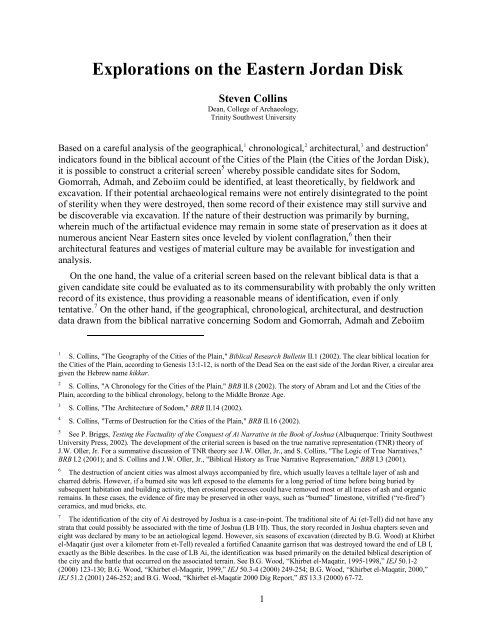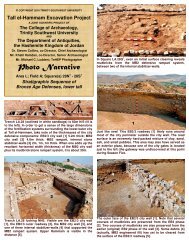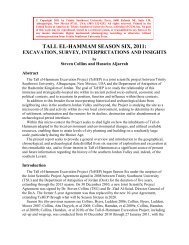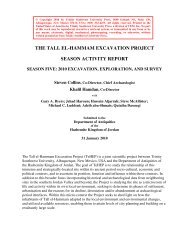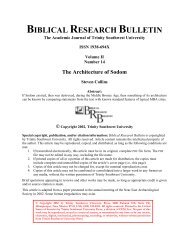Explorations on the - Tall el-Hammam Excavation Project, Jordan
Explorations on the - Tall el-Hammam Excavation Project, Jordan
Explorations on the - Tall el-Hammam Excavation Project, Jordan
Create successful ePaper yourself
Turn your PDF publications into a flip-book with our unique Google optimized e-Paper software.
<str<strong>on</strong>g>Explorati<strong>on</strong>s</str<strong>on</strong>g> <strong>on</strong> <strong>the</strong> Eastern <strong>Jordan</strong> Disk<br />
Steven Collins<br />
Dean, College of Archaeology,<br />
Trinity Southwest University<br />
Based <strong>on</strong> a careful analysis of <strong>the</strong> geographical, 1 chr<strong>on</strong>ological, 2 architectural, 3 and destructi<strong>on</strong> 4<br />
indicators found in <strong>the</strong> biblical account of <strong>the</strong> Cities of <strong>the</strong> Plain (<strong>the</strong> Cities of <strong>the</strong> <strong>Jordan</strong> Disk),<br />
it is possible to c<strong>on</strong>struct a criterial screen 5 whereby possible candidate sites for Sodom,<br />
Gomorrah, Admah, and Zeboiim could be identified, at least <strong>the</strong>oretically, by fi<strong>el</strong>dwork and<br />
excavati<strong>on</strong>. If <strong>the</strong>ir potential archaeological remains were not entir<strong>el</strong>y disintegrated to <strong>the</strong> point<br />
of sterility when <strong>the</strong>y were destroyed, <strong>the</strong>n some record of <strong>the</strong>ir existence may still survive and<br />
be discoverable via excavati<strong>on</strong>. If <strong>the</strong> nature of <strong>the</strong>ir destructi<strong>on</strong> was primarily by burning,<br />
wherein much of <strong>the</strong> artifactual evidence may remain in some state of preservati<strong>on</strong> as it does at<br />
numerous ancient Near Eastern sites <strong>on</strong>ce lev<strong>el</strong>ed by violent c<strong>on</strong>flagrati<strong>on</strong>, 6 <strong>the</strong>n <strong>the</strong>ir<br />
architectural features and vestiges of material culture may be available for investigati<strong>on</strong> and<br />
analysis.<br />
On <strong>the</strong> <strong>on</strong>e hand, <strong>the</strong> value of a criterial screen based <strong>on</strong> <strong>the</strong> r<strong>el</strong>evant biblical data is that a<br />
given candidate site could be evaluated as to its commensurability with probably <strong>the</strong> <strong>on</strong>ly written<br />
record of its existence, thus providing a reas<strong>on</strong>able means of identificati<strong>on</strong>, even if <strong>on</strong>ly<br />
tentative. 7 On <strong>the</strong> o<strong>the</strong>r hand, if <strong>the</strong> geographical, chr<strong>on</strong>ological, architectural, and destructi<strong>on</strong><br />
data drawn from <strong>the</strong> biblical narrative c<strong>on</strong>cerning Sodom and Gomorrah, Admah and Zeboiim<br />
1 S. Collins, "The Geography of <strong>the</strong> Cities of <strong>the</strong> Plain," Biblical Research Bulletin II.1 (2002). The clear biblical locati<strong>on</strong> for<br />
<strong>the</strong> Cities of <strong>the</strong> Plain, according to Genesis 13:1-12, is north of <strong>the</strong> Dead Sea <strong>on</strong> <strong>the</strong> east side of <strong>the</strong> <strong>Jordan</strong> River, a circular area<br />
given <strong>the</strong> Hebrew name kikkar.<br />
2 S. Collins, "A Chr<strong>on</strong>ology for <strong>the</strong> Cities of <strong>the</strong> Plain," BRB II.8 (2002). The story of Abram and Lot and <strong>the</strong> Cities of <strong>the</strong><br />
Plain, according to <strong>the</strong> biblical chr<strong>on</strong>ology, b<strong>el</strong><strong>on</strong>g to <strong>the</strong> Middle Br<strong>on</strong>ze Age.<br />
3 S. Collins, "The Architecture of Sodom," BRB II.14 (2002).<br />
4 S. Collins, "Terms of Destructi<strong>on</strong> for <strong>the</strong> Cities of <strong>the</strong> Plain," BRB II.16 (2002).<br />
5 See P. Briggs, Testing <strong>the</strong> Factuality of <strong>the</strong> C<strong>on</strong>quest of Ai Narrative in <strong>the</strong> Book of Joshua (Albuquerque: Trinity Southwest<br />
University Press, 2002). The dev<strong>el</strong>opment of <strong>the</strong> criterial screen is based <strong>on</strong> <strong>the</strong> true narrative representati<strong>on</strong> (TNR) <strong>the</strong>ory of<br />
J.W. Oller, Jr. For a summative discussi<strong>on</strong> of TNR <strong>the</strong>ory see J.W. Oller, Jr., and S. Collins, "The Logic of True Narratives,"<br />
BRB I.2 (2001); and S. Collins and J.W. Oller, Jr., "Biblical History as True Narrative Representati<strong>on</strong>," BRB I.3 (2001).<br />
6 The destructi<strong>on</strong> of ancient cities was almost always accompanied by fire, which usually leaves a t<strong>el</strong>ltale layer of ash and<br />
charred debris. However, if a burned site was left exposed to <strong>the</strong> <strong>el</strong>ements for a l<strong>on</strong>g period of time before being buried by<br />
subsequent habitati<strong>on</strong> and building activity, <strong>the</strong>n erosi<strong>on</strong>al processes could have removed most or all traces of ash and organic<br />
remains. In <strong>the</strong>se cases, <strong>the</strong> evidence of fire may be preserved in o<strong>the</strong>r ways, such as “burned” limest<strong>on</strong>e, vitrified (“re-fired”)<br />
ceramics, and mud bricks, etc.<br />
7 The identificati<strong>on</strong> of <strong>the</strong> city of Ai destroyed by Joshua is a case-in-point. The traditi<strong>on</strong>al site of Ai (et-T<strong>el</strong>l) did not have any<br />
strata that could possibly be associated with <strong>the</strong> time of Joshua (LB I/II). Thus, <strong>the</strong> story recorded in Joshua chapters seven and<br />
eight was declared by many to be an aetiological legend. However, six seas<strong>on</strong>s of excavati<strong>on</strong> (directed by B.G. Wood) at Khirbet<br />
<strong>el</strong>-Maqatir (just over a kilometer from et-T<strong>el</strong>l) revealed a fortified Canaanite garris<strong>on</strong> that was destroyed toward <strong>the</strong> end of LB I,<br />
exactly as <strong>the</strong> Bible describes. In <strong>the</strong> case of LB Ai, <strong>the</strong> identificati<strong>on</strong> was based primarily <strong>on</strong> <strong>the</strong> detailed biblical descripti<strong>on</strong> of<br />
<strong>the</strong> city and <strong>the</strong> battle that occurred <strong>on</strong> <strong>the</strong> associated terrain. See B.G. Wood, “Khirbet <strong>el</strong>-Maqatir, 1995-1998,” IEJ 50.1-2<br />
(2000) 123-130; B.G. Wood, “Khirbet <strong>el</strong>-Maqatir, 1999,” IEJ 50.3-4 (2000) 249-254; B.G. Wood, “Khirbet <strong>el</strong>-Maqatir, 2000,”<br />
IEJ 51.2 (2001) 246-252; and B.G. Wood, “Khirbet <strong>el</strong>-Maqatir 2000 Dig Report,” BS 13.3 (2000) 67-72.<br />
1


